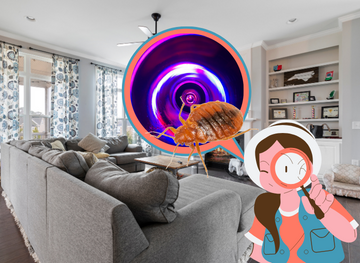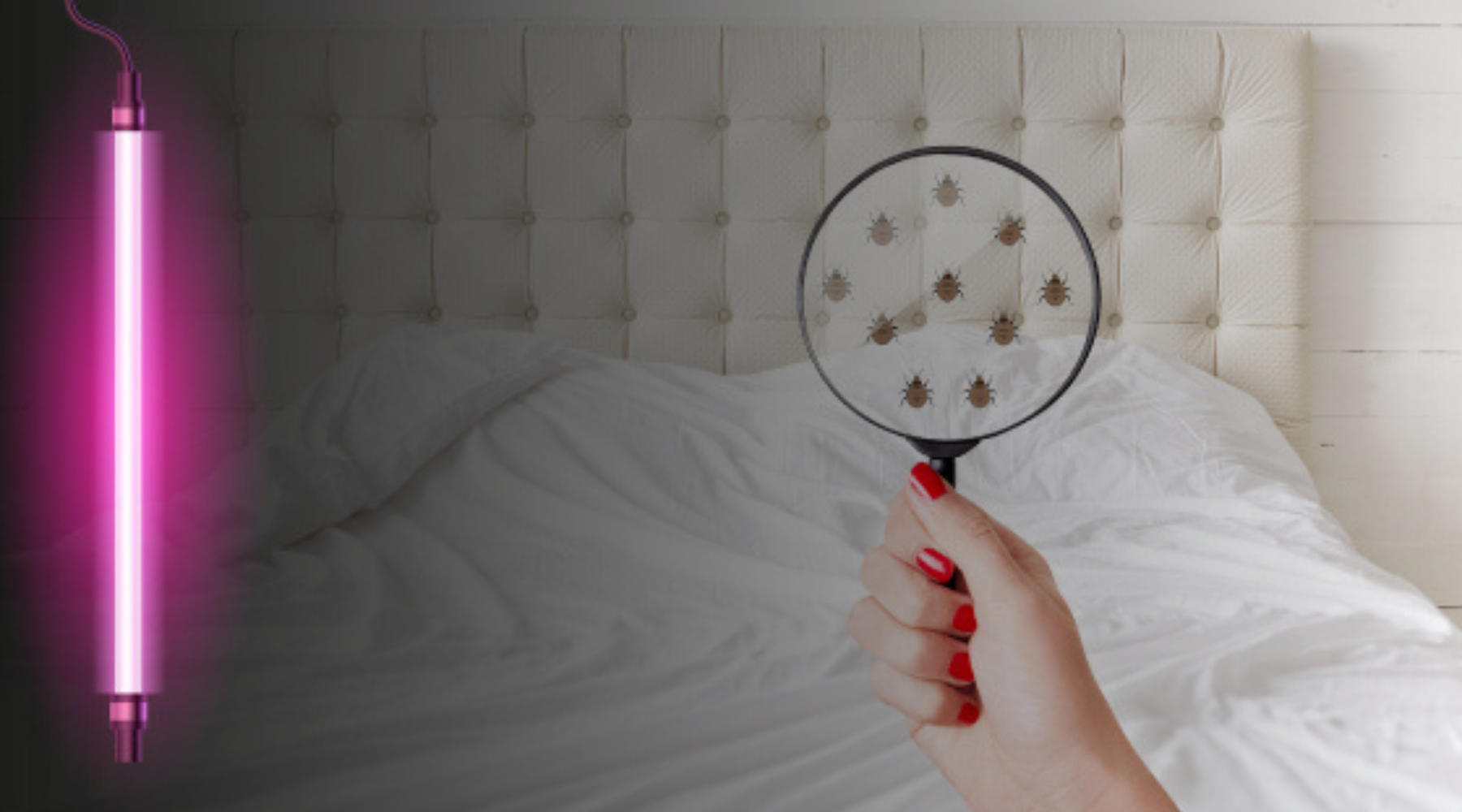Have you ever suspected that you may have bed bugs in your home but weren’t sure how to tell? Well, one way to find out is with a black light! Black lights can detect bed bugs even when they may be hard to see with the naked eye. Read on to learn more about how black lights can help you determine if you have a bed bug infestation.

How To Find Bed Bugs with Black Light
With a black light, you can scan your home to look for bed bugs, as they tend to reflect the light of different wavelengths. This type of light makes it easier to detect bed bugs in hard-to-reach areas such as cracks and crevices in your walls or furniture.
Black lights are also useful to detect droppings left by bed bugs since they will glow under the special light. However, due to their size, you may need a magnifying glass to spot bed bugs.
How Does UV Light or Black Light Track Bed Bugs?
UV lights or black lights work by making bedbugs visible since the organisms fluoresce when exposed to ultraviolet radiation. This makes bed bugs appear as dark brown or black spots against a bright background and can often be used to detect even very small insects.
By using UV Lights, you can easily spot the tell-tale signs of an infestation such as bedbug shed skins and feces, as well as spot actual bed bugs in the environment. With this method, it is possible to accurately assess the severity of the bed bug infestation and plan out effective control plans accordingly.

Can UV Light Help to Detect Bed Bugs?
Yes, you can use UV light to detect bed bugs. The wavelength of ultraviolet light is shorter than visible light, so it can penetrate hard-to-reach and dark areas and detect bed bugs that may otherwise be difficult to see.
Aside from detecting bed bugs, UV light is also effective in spotting bed bug trails like their droppings, eggs, and signs of an infestation such as blood stains or shells which would be more visible against the black background of a black light.
Steps in Using UV Light in Detecting Bed Bugs
Dealing with bed bugs can be a real headache, but there are simple and effective ways to detect bed bugs. One of these is using UV light. Simply follow these steps to get started:
- Turn off all lights in the room so you can better see signs of bed bugs while using the UV light.
- Scan the area with the blacklight, paying special attention to cracks, crevices, and other small areas where bed bugs are likely to hide.
- Look for any tell-tale signs such as dark spots, shells, or droppings that will glow fluorescent under UV lights.
- Use a magnifying glass if possible, for a closer look at any suspicious spots, and take action if you spot any evidence of infestation.
Make use of these steps to ensure that you can make the most out of your UV light as you search for bed bugs in your house.

Can UV Lights be Used for Killing Bed Bugs?
Unfortunately, UV light can’t be used to kill bed bugs. It is only effective for detecting their presence. If you notice any signs of bedbugs, use other methods such as vacuuming, steaming, and the use of insecticides to effectively get rid of bed bugs. The use of these methods is what kills bed bugs almost immediately.
Further, be sure to keep your space clean and clutter-free as this helps reduce the risk of bed bugs becoming established in your home.
Does a Bed Bug Glow Under a UV Light?
You may not know this, but bed bugs glow a bright purple color when exposed to UV light. This is thanks to a fluorescent pigment that is found inside their bodies, making it easy to detect any possible infestations using UV light in a dark room. Of course, since not all rooms are completely dark, you may need to use a flashlight as well for optimal results.
Are Bed Bugs Able to See UV Light?
Bedbugs are not able to see UV light, as they do not have the specialized receptors in their eyes that are needed to detect it. However, they can still sense it indirectly and move away from its source due to its heat or intensity.
Although bedbugs cannot see UV light, they can still detect it in other ways. They have specialized receptors on their antennae and bodies which can sense the heat or intensity of the light source and respond accordingly. This allows bed bugs to locate sources of UV light, even if they can’t actually see it. As a result, they may move away from it or take measures to hide from it to protect themselves.

Do UV Light Attract Bed Bugs?
UV light can attract bedbugs, but only temporarily. Bedbugs will move closer to sources of UV light initially since they are drawn by the heat that is emitted, but they do not stay there long as it can be damaging to them.
The light can actually sterilize or kill bed bugs within seconds if they remain in it for too long. Therefore, while UV light makes adult bed bugs attracted to it in the short term, it is still typically not an effective way to use UV light to control a bedbug population or eliminate bed bugs.
Ways to Search for Bed Bugs Using UV Light
Using a UV flashlight to search for bedbugs is an effective way of identifying and controlling bed bug infestations. Areas, where bedbugs are likely to hide, should be the starting point for using the light: cracks and crevices in bedroom furniture, walls, floors, and other hard surfaces. Other places to look include:
- Mattresses
- Box Spring
- Pillows
- Bed Frame
- Doors
- Windows
- Door Frames
- Baseboards or Wood Trim
Shining the UV light on these areas increases the chances of spotting any bedbug activity or droppings that have accumulated over time.

What Should You Do Once You Find Bed Bugs with a UV Light?
Once you have found evidence of bedbugs with a UV light, several steps can be taken to control the bed bug infestation. These include:
- Vacuuming and cleaning the affected areas regularly
- Sealing off any cracks, crevices, and gaps in walls or furniture as this will stop the bugs from re-infesting.
- Use insecticides specifically designed for bedbugs to treat any live bugs or eggs you may find in the area.
Contacting a professional pest control company for assistance if needed.
Is Using UV Light Recommended for Detecting Bed Bugs?
UV light is a great way to detect bedbugs easier and can help ensure your home remains bug-free! It works by illuminating fluorescent proteins in the bugs’ shells, making them visible against other objects. Not only that, but it can also help you find possible hiding places where bedbugs may live or lay eggs.
Plus, using UV light is much easier than trying to spot bed bugs with the naked eye. To make sure your home remains bug-free, be sure to use UV light alongside other methods such as vacuuming, cleaning, sealing off cracks or gaps, and consulting professional pest control companies if needed.
How Do Bed Bugs Look Under the Black Light
Have you ever spotted a bedbug under the black light? Its fluorescent proteins emit a bright greenish-yellow glow, allowing it to stand out against other objects and surfaces in the dark.
Bedbugs of any age, size, and type will be visible this way – whether they’re adult bugs, larvae, or even eggs! For a better inspection, make sure to turn off all lights and switch on the black light. Besides their bright yellow-green color, bedbugs are typically small, flat, and oval in shape.
To get a closer view of bed bugs under UV light, remember to inspect any potential hiding spots such as cracks, crevices, and furniture too. Don’t forget that they generally hide during the day, so it might help to move furniture around for an even better inspection!

Are There Other Equipment Needed to Detect Bed Bugs with UV Light?
You will need black light, which usually produces ultraviolet light at wavelengths of 365 nm to 400 nm. This type of light will cause evidence of bed bugs such as eggs, droppings, and shells to fluoresce and be easy to spot.
If possible, you should also consider using a magnifying glass to examine any dark brown dots more closely.
Are There Other Special Lights that Can Be Used for Detecting Bed Bugs Aside from Black Light?
While black light is the best option to detect bed bugs, there are also other special lights that can be used.
One such light is a fluorescent bulb that emits short-wave ultraviolet (UV) radiation. This type of light will cause bedbugs to emit a faint glow and although they may not be as bright as they appear under a black light, it is still possible to spot them.
For a more efficient inspection, however, it’s best to use a black light and remember to inspect any potential hiding spots such as cracks and crevices in furniture or bedding when the lights are off.

What Other Insects Can be Seen Under the UV Light Aside from Bed Bugs?
In addition to bedbugs, other insects like fleas and moths can also be seen under UV light. Fleas emit a blue-white glow due to the presence of fluorescent proteins in their bodies, while moths will appear as bright green spots against an otherwise black background.
Other common pests such as carpet beetles, cockroaches, and clothes moths can also be seen under UV light. It is important to note however that not all insect species are fluorescent, so it’s best to consult an entomologist if you’re unsure about what you’re seeing.
Dealing with a Bed Bug Infestation After UV Light Detection
A bed bug infestation can be a difficult problem to deal with, but it’s important to act quickly. Once you’ve identified the presence of bed bugs using UV light or black light, you should begin a bed bug treatment plan as soon as possible.
This might include vacuuming and steam cleaning the area where the pests have been spotted and using professional insecticides or traps to eradicate them. It’s also important to regularly inspect for new infestations since bed bugs can easily spread from room to room within a house or apartment.
Finally, make sure to clean up any mess left behind by bed bugs, such as feces and shed skin.
Preventing Another Bed Bug Infestation from Happening
Prevention is always the best defense when it comes to bed bug infestation. Regularly checking your home with a UV light or black light can help you spot any new activity early on before it has time to spread.
Additionally, you should regularly vacuum, and steam clean your home, particularly in areas where bed bugs are likely to hide, such as between mattresses, under beds, and behind other bedroom furniture. You should also launder your linens and clothing frequently using hot water and detergent.
Also remember that whenever you’re traveling, inspect hotel rooms for signs of bed bugs before unpacking, and never leave your suitcase or belongings on the floor in an unfamiliar place. Keep in mind that a single bed bug that is ready to lay bed bug eggs in your suitcase or clothes can already start an unexpected bed bug infestation in your home.







